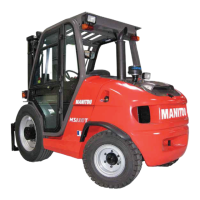1 - 15
E - TAKING UP AND LAYING A HIGH LOAD ON TYRES
You must not raise the mast if you have not checked the transverse attitude of the lift truck
(see: INSTRUCTIONS FOR HANDLING A LOAD: C - TRANSVERSE ATTITUDE OF THE LIFT
TRUCK).
REMINDER: Make sure that the following operations can be performed with good visibility
(see: OPERATIONS INSTRUCTIONS UNLADEN AND LADEN: D - VISIBILITY).
TAKING UP A HIGH LOAD ON TYRES
- Ensure that the forks will easily pass under the load.
- Keeping the mast vertical (1), advance the lift truck and raise the forks to level with the
load (2) (fig. E1).
- Manoeuvre carefully and gently to bring the forks to the stop in front of the load (fig. E2).
Set the handbrake and place the reversing lever to neutral.
- Slightly lift the load (1) and incline the carriage (2) backwards to stabilize the load (fig.
E3).
- Tilt the load sufficiently backwards to ensure its stability.
- Reverse the lift truck (1) very carefully and gently to free the load. Lower the mast (2) to
bring the load into transport position (fig. E4).
LAYING A HIGH LOAD ON TYRES
- Approach the load in the transport position in front of the pile (fig. E5).
- Raise the mast (1) until the load is higher than the pile and move the lift truck forward
(2) (fig. E6) very carefully and gently, until the load is over the pile. Put the handbrake on
and set the reversing lever to neutral.
- Place the load in a horizontal position by tilting the mast forwards (1) and lay it down on
the pile (2) while checking the correct positioning of the load (fig. E7).
- Reverse the lift truck (1) very slowly and carefully to release the forks (fig. E8). Then set
them into transport position.
